Steel Will Druid 230 Reviewed
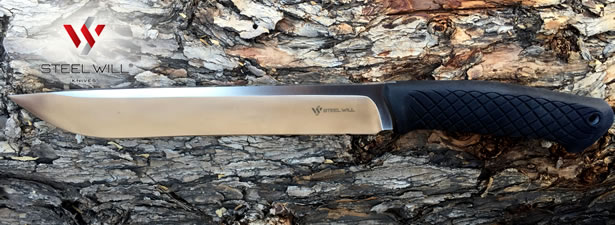
Marketing from Steel Will
This heavy camping knife is designed for the toughest jobs. It can function as an axe or machete yet still be capable enough to be used for common tasks.
Manufacturer: Steel Will, steelwillknives.com
Model: Druid 230
Overall Length: 14.5 inch (36.8 cm)
Blade Finish: Satin
Blade Material: 9Cr18MoV High Carbon Chromium Bearing Stainless Steel
Blade-HRC: 58-59
Blade Length: 9.06 inch (23.0 cm)
Blade Thickness: 0.2 inch (5.0 mm)
Handle Material: Thermoplastic Elastomer (TPE) Handle
Handle Length: 5.39 inch (13.7 cm)
Weight: 11.46 oz
Accessories: Leather Belt Sheath
Warranty: Limited Lifetime Warranty against any manufacturing or material defects
Origin: Made in China
MSRP: $129.99
The Review
I love big blades, and I love small blades… And just about every blade in between. Especially bushcraft blades. But when you come across a blade built for processing wood, well those are the most fun and I just have to try it out. Enter the Druid 230 from Steel Will. Today we’ll be playing around with one just to see how much fun we can have with it. So Let’s get started…

Initial Thoughts
I first saw images of Steel Will’s Druid 230 on their website a few months back and I was quite impressed. I knew it was a little over foot long, but I did not realize just how massive the blade really was until I went to pull it out of the box. To gain access to the blade inside, simply slide the inner box out from either side of the outer box to reveal it. The blade itself is covered with a thin cardboard sleeve and fixed to a cardboard platform with two hook and loop straps to protect the blade during shipping. Below the cardboard platform lies the durable leather belt sheath.
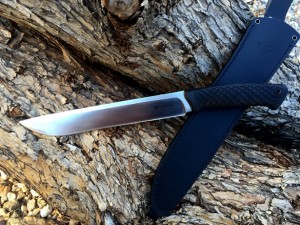 The Druid 230 is 14.5″ long with a massive 9″ blade made from a rock-solid 9Cr18MoV high-carbon chromium bearing stainless steel with a beautiful scratch-resistant brushed satin finish. It features a long full-tang design with a 90° spine, a subtle drop-point and an ever so slight recurve that is factory-sharpened with a high-flat saber grind and micro-bevel.
The Druid 230 is 14.5″ long with a massive 9″ blade made from a rock-solid 9Cr18MoV high-carbon chromium bearing stainless steel with a beautiful scratch-resistant brushed satin finish. It features a long full-tang design with a 90° spine, a subtle drop-point and an ever so slight recurve that is factory-sharpened with a high-flat saber grind and micro-bevel.
The black TPE (thermoplastic elastomer) handle is little over 5″ long, moulded with an attractive wavy grid pattern and an enlarged rear bolster for a durable slip-resistant grip that is well-balanced and extremely comfortable to wield wet or dry. Near the end of the handle, there is a lined lanyard hole just big enough to fit some paracord through. The tang protrudes slightly beyond the lanyard hole and the end of the handle forming a smooth pommel surface.
The Druid 230 comes with an attractive form-fitted black leather belt sheath nearly 12.5″ long leaving just 2″ of the handle exposed and accessible. The sheath features a dangler-style belt loop capable of holding a belt up to 2″ wide, a small drainage hole and a loop at the end for a leg lanyard.
Features
Now for a closer look at the Druid 230 and its features…
The Blade
From tip to pommel, the Druid 230 is a lengthy, well-balanced full-tang fixed-blade knife nearly 14.5″ long, 0.2″ thick, and 1.25″ at its widest point. The blade is made from a rugged slab of 9Cr18MoV, a Chinese stainless steel alloy comparable to the Japanese AUS-8 and the American 440B. 9Cr18MoV is a high carbon, high chromium stainless steel alloy that is best heat-treated to a hardness somewhere between 58-59 HRC providing a good balance between strength, rigidity, edge retention and resistance to wear so it is not overly difficult to sharpen, but holds an edge rather well.
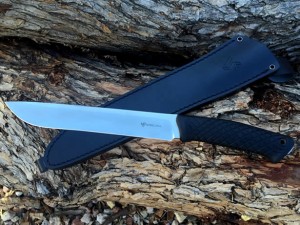 To further enhance the integrity of the tangs used in Steel Will knives, there are no sharp corners or tight radiuses which tend to create weak points susceptible to stress.
To further enhance the integrity of the tangs used in Steel Will knives, there are no sharp corners or tight radiuses which tend to create weak points susceptible to stress.
High carbon stainless steel alloys are popular for use in knife blades due to its exceptional rust and corrosion resistant properties, and 9Cr18MoV is no different. However, it is important to note that stainless steel alloys are only rust and corrosion resistant, and not entirely rust and corrosion proof. Therefore, is still susceptible to various forms of rust and corrosion without proper care and maintenance. If the blade becomes wet, simply dry it thoroughly and lightly coat it with a protective oil before you pack it away and it will likely last you a lifetime.
The Druid 230 features an attractive drop-point profile, best explained as a blade with a convex curve from the spine to the tip of the blade which provides a strong, robust tip that is easy to direct when chopping, cutting and prying, but is often less suitable for piercing. The Druid 230 also features a factory-sharpened edge with a high-flat saber grind and micro-bevel. This edge profile is very easy to maintain on a flat stone or diamond dust sharpeners both in and out of the field.
The blade itself is just over 9″ long with a sharp 90° edge along the entire length of the spine, perfect for striking against a ferro rod without fear of damaging the edge or the beautiful brushed satin finish. This finish is not only attractive to look at, it also tends to hide minor wear and scratches rather well, keeping the blade looking good much longer.
The Handle
The 5″ handle is made from a durable black synthetic thermoplastic elastomer (TPE) overmolded onto the Druid 230 and locked in place with a 1/4″ lanyard tube, perfect for keeping a paracord lanyard for quick and easy knife retention.
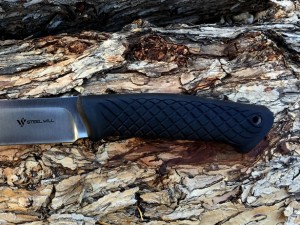 The handle features an attractive, aggressively textured grid pattern and a pronounced rear bolster providing an exceptional slip-resistant grip that is extremely comfortable to wield wet or dry. It also works well with gloves, but they are certainly not necessary with this grip pattern. The tang protrudes just beyond the lanyard hole and the end of the handle providing a smooth pommel surface for hammering various materials and stakes.
The handle features an attractive, aggressively textured grid pattern and a pronounced rear bolster providing an exceptional slip-resistant grip that is extremely comfortable to wield wet or dry. It also works well with gloves, but they are certainly not necessary with this grip pattern. The tang protrudes just beyond the lanyard hole and the end of the handle providing a smooth pommel surface for hammering various materials and stakes.
Thermoplastic elastomers (TPE) are sometimes referred to as thermoplastic rubber, and made from a comprehensive mixture of plastic and rubber polymers that provide the handle material with the best characteristics of plastic and rubber.
The Sheath
The sheath that comes with the Druid 230 is an attractive black leather dangler-style belt sheath nearly 12.5″ long leaving only the topmost 2″ of the handle exposed and accessible. The high-grade leather is durable and form-fitted to hold the blade securely in place unless you physically draw the weapon. The sheath also features a dangler belt loop that is capable of holding a belt up to 2″, a small drainage hole near the bottom of the sheath and a small lanyard tassel at the end of the sheath for a leg lanyard.

Functional Testing
So lets what the Druid 230 can do… In order to provide a some sort of apples-to-apples comparison between blades, I will be performing six durability and functional tests; Chopping, Batoning, Feather Stick, Fine Blade Control, Tip Strength and Edge Retention. In a survival situation, all resources are fair game. However, since I am not in a life-or-death situation, I’ll stick to some dead wood that I have lying around for these tests.
Chopping
To test the Druid 230 at chopping, I thought I would buck a 6″ log after delimbing it into a few pieces that I could later split with a baton in the next test.
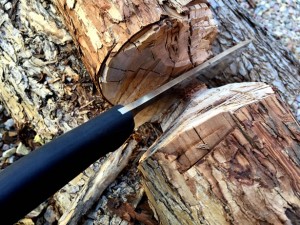 The Druid 230 has a long slender blade profile that it is very well-balanced, but it feels a little light for heavy chopping activities. The handle is extremely comfortable to wield and the ergonomics are fantastic.
The Druid 230 has a long slender blade profile that it is very well-balanced, but it feels a little light for heavy chopping activities. The handle is extremely comfortable to wield and the ergonomics are fantastic.
I found that I could generate a lot more power using a three-finger grip with my smallest finger against the butt of the handle and wrapping around the rear bolster. The added leverage translated directly into a noticeable increase in striking force. Using this method, I was easily able to chop through the smaller limbs and foliage as I delimbed the branch, often only a single swing was necessary. Not much difficulty whatsoever. This made delimbing the branch quick and easy.
To buck a log after delimbing it, you simply strike the log at a 45° angle from two perpendicular directions along the cut-line, effectively making a “V” in the material, otherwise known as the kerf. The kerf should equal the diameter of the limb or trunk, and when cutting from both sides, the kerf would essentially be half diameter. This works with branches of any size.
It only took a few swings at the large branch before I realized just how sharp and well-balanced this blade really is… Though, at 11.5 ounces it really is a little light for chopping a branch of this size. It took quite a long time to chop all the way through the branch both times, but due to its light weight I was not overly fatigued. The blade bit deeply into the material and the chips were flying with each swing. The Druid 230 definitely held its own. However, if the Druid 230 was double its weight it would certainly be much more formidable as a chopper.
 While you would certainly be better off having an axe on hand for processing the heavier stuff like this, I did not run across anything that the Druid 230 could not do that would easier with small handaxe less than 12″ in size, except for hammering stuff of course. A larger handaxe, and the game is completely different. So if Druid 230 is all you’ve got, simply work with some smaller material and you’ll be just fine.
While you would certainly be better off having an axe on hand for processing the heavier stuff like this, I did not run across anything that the Druid 230 could not do that would easier with small handaxe less than 12″ in size, except for hammering stuff of course. A larger handaxe, and the game is completely different. So if Druid 230 is all you’ve got, simply work with some smaller material and you’ll be just fine.
Batoning
To test the Druid 230 with a baton, I split the two 6″ logs that I had just made during the first test. With the Druid 230’s 9″ blade, I felt that 6″ was close to the maximum diameter that I could easily half without having to run the outer edge first. For this test, I used 3″ baton about 2′ in length to strike the top of the spine as I worked my way through each log, first halves, then quarters, and so on until I had a nice pile of small kindling. The slender blade and high-flat grind showed little or no sign of drag as it made its way through the log, even through some of the nastiest gnarled wood and knots.
At nearly 0.2″ thick, the long spine and high-flat grind of the Druid 230 worked perfectly with a baton. The handle geometry provided a lot of control over the blade, and the TPE handle material did absorb most of the shock. Sure it wasn’t completely shockless, but I didn’t feel anything significant through handle whatsoever.
Fine Blade Control
When I’m testing out a new knife, I always try making spear tips, tent pegs, and sometimes even trap triggers and the like, but I haven’t commented much about it in past reviews. However, I recently read a request in a popular FB group for reviewers to start including more real-world functional testing in their reviews, and I thought it was a pretty good idea so I thought I’d start adding more here and there as I go…
 To test the Druid 230 at some fine blade control tasks, I grabbed a few branches a little smaller than 1″ in diameter that I had previously delimbed off the main branch earlier, and chopped them down to about 10″ in length. Then I began cutting in a “V” notch about 1/2″ deep and approximately 1″ from the top of the peg. Next, I cut the point on the other end to finish off the tent peg before repeating a few more times for good measure.
To test the Druid 230 at some fine blade control tasks, I grabbed a few branches a little smaller than 1″ in diameter that I had previously delimbed off the main branch earlier, and chopped them down to about 10″ in length. Then I began cutting in a “V” notch about 1/2″ deep and approximately 1″ from the top of the peg. Next, I cut the point on the other end to finish off the tent peg before repeating a few more times for good measure.
To further test fine blade control, I tried my hand at making a really simple split-stick deadfall trap just for fun. With a 1/2″ stick about 10″ long, I carefully marked the side of the stick and cut it in half. This is the support stick. Then I notched the two halves where they fit together making a small 1/4″ hole down the center to hold the bait stick. The bait stick should be pointed at one end to hold the bait, and tapered at the other end so it fits snuggly into the notched hole between the two halves of the support stick.
Feathering A Stick
For this test, I chose to feather one of the pieces of kindling that I had split while batoning. It was a little over 1.5″ square and around 12″ in length. I began taking long strokes down each of the corners as I started rounding the stick. The more round the stick became, the finer the curls quickly followed suite.
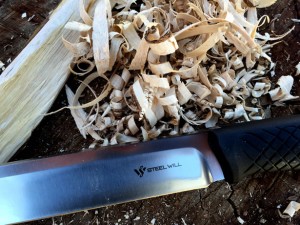 As I worked my way around the stick careful not to dig in too much, I was able to achieve some pretty thin curls with the high-flat grind. I was quite impressed. I thought I would have much more trouble than I did with the extra long blade. Out of the box the Druid 230 was certainly sharp enough to process the shavings, and the high-flat blade grind only made it easier.
As I worked my way around the stick careful not to dig in too much, I was able to achieve some pretty thin curls with the high-flat grind. I was quite impressed. I thought I would have much more trouble than I did with the extra long blade. Out of the box the Druid 230 was certainly sharp enough to process the shavings, and the high-flat blade grind only made it easier.
Tip Strength
Testing the its ability to stab or pierce without bending or breaking the tip, I drove the blade into the end of a 12″ stump with a baton about an 1-1/2″ deep. Then I loosened the blade using a side-to-side motion until it became loose enough to pull out. I repeated this action a few more times without any sign of bending, breaking, or chipping.
The final tip test was to bore a hole into the side of a 3″ log simply by rotating the blade back and forth numerous times. After a few minutes, I had a hole approximately 1″ deep and 1″ in diameter. The tip is very stout and performed exceptionally well with no sign of damage whatsoever.
Edge Retention
After all of the other functional testing had been completed, the final test was to slice through a single sheet of copy paper which the Druid 230 did so very cleanly. Not only could it slice through the paper, I was able to slice 1/4″ strips. Sure it was not shaving sharp, but after chopping and batoning, I was a bit surprised it held its edge so well. At the end of the day, there were no sign of cracks or chips of any kind, and with a quick wipe with a lightly oiled rag you could barely tell it had even been used.
Final Thoughts
Steel Will’s Druid 230 is a rock-solid performer made from quality materials. Not only is it a rugged lightweight chopper and survival blade, it is equally capable of performing many light bushcraft tasks, and very comfortable to wield for extended periods of time without feeling a lot of fatigue. Everything that you would expect from a good well-rounded outdoor knife. Its quality is very high, and with a little care and maintenance from time to time, this blade should last you a lifetime.
For an 11.5 ounce knife, the Druid 230 performs exceptionally well at many of the same tasks that a small handaxe or machete would commonly be used for. But if you are looking for a long-bladed chopper that can completely eliminate the need for an axe or a machete, then you really need to be looking elsewhere… The Druid 230 is not a huge multi-pound chopper, and it was never designed to fill that space.
I really like the feel of the handle, but I do wish the finger guard was a little more pronounced and there was a finger choil just in front of it providing a little more control while working on finer tasks. I also wouldn’t mind seeing some light jimping on the spine just in front of the handle.
At a little over 14″, the Druid 230 is a good chopper and a great survival blade. One of my favorite blades from Steel Will so far. I’ll certainly be enjoying this one for years to come.
You can find this and other Steel Will knives here: http://amzn.to/2bv7Joq
![]()
About SMG Inc and Steel Will
 SMG Inc. is an American company established in 2008. They specialize in the production of pneumatic guns under the brand “Gletcher”, as well as tactical and outdoor knives under the brand “Steel Will Knives”. SMG prides themselves on making products with the highest level of performance, quality, and craftsmanship. For more information on their entire line of products, please visit www.smgoutdoor.com.
SMG Inc. is an American company established in 2008. They specialize in the production of pneumatic guns under the brand “Gletcher”, as well as tactical and outdoor knives under the brand “Steel Will Knives”. SMG prides themselves on making products with the highest level of performance, quality, and craftsmanship. For more information on their entire line of products, please visit www.smgoutdoor.com.
OUR BRANDS
Gletcher is a brand of pneumatic guns and accessories, established by SMG Inc. Our slogan, “Military Precision”, emphasizes the high level of implementation of our air guns both in function and design. It also reflects the passion it evokes in our customers. In creating the Gletcher brand and products, we tried to fill a void for customers who appreciate firearms but due to cultural and regulatory issues were unable to own these types of items.
We are proud to debut our new brand of knives called “Steel Will”. In creating these beautiful knives, we’ve combined the finest steel with extremely practical and innovative designs. The result is a line of knives that are meant to be used and adored by their owners. Steel Will Knives are produced according to the highest standards of quality, using the most modern methods of production. We have set a high bar for our products and will continue to do so in the future. We are confident that the quality of our knives will meet the requirements of the most discerning buyers.
--